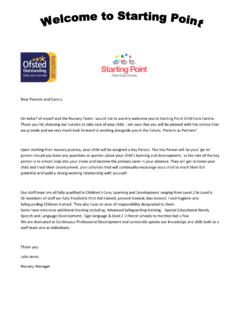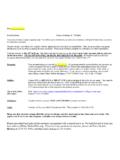Transcription of Pediatric and Primary Care EMR Business Process …
1 Copyright 2009 Charles Webster, Mark Copenhaver Pediatric and Primary care EMR Business Process Management: A Look Back, a Look Under the Hood, and a Look Forward A White Paper Charles Webster, Mark Copenhaver EncounterPRO Healthcare Resources, Inc., Atlanta, Georgia, USA Abstract. We describe an ambulatory electronic health record (EHR) workflow management system (WfMS) employed to create a high-usability Pediatric elec-tronic medical record (EMR) workflow system that is currently in use by 4000 users at 300 medical offices and has been deployed since 1995. WfMS features and functionality include a workflow engine, workflow Process definition editor, and a universally viewable annotated worklist that represents patient location and task status in real time.
2 Clinical data flow into and out of the EncounterPRO Pe-diatric EMR Workflow System via the EncounterPRO Health Information Ex-change (EPHIE, HIE) automatically and inexpensively due to coordinated workflow management across EMR and HIE subsystems. Business Process man-agement (BPM) add-on modules address the three most important dimensions of ambulatory EMR value: clinical performance, patient satisfaction, and practice profitability. Written physician comments about the resulting electronic medical record (EMR) workflow systems (two Pediatric and one obstetrics, gynecology and family medicine) from three award winning case studies support the impor-tance of workflow or Process -aware EMRs to successful EMR deployment.
3 Key Words: Electronic health records, electronic medical records, workflow management systems, Business Process management, health information ex-change, pediatrics 1 Introduction The EncounterPRO EHR Workflow Management System [1, 2, 3] is a certified electronic health record that implements more than 200 EMR functional requirements on a workflow management system foundation [4]. It is the only commercial EHR WfMS for ambulatory medical office practice of which we know. In 1995 the EncounterPRO EHR WfMS was used to create and deploy the EncounterPRO Pediatric Workflow System to its first Pediatric prac-tice. 2 This report describes the means by which workflow Process definitions (called workplans by EncounterPRO developers and users) are created, edited, and thereby gener-ate a specialty-specific EMR workflow system such as a Pediatric EMR workflow system; coordination of workflow between the EncounterPRO Pediatric EMR Workflow System and the EncounterPRO Health Information Exchange; plans to add Pediatric -specific Business Process management functionality directed towards optimizing clinical performance, patient satisfaction, and practice productivity.
4 And evidence that pediatricians and Primary care pro-viders are receptive to the use of workflow or Process -aware EMRs at the point of care . EMR workflow systems are more usable than EMRs without workflow management ca-pability. Consider these usability principles: naturalness, consistency, relevance, supportive-ness, and flexibility. Pediatric (for example) EMR workflow systems more naturally match the task structure of a pediatrician s office through execution of Pediatric -specific workflow Process definitions. These definitions consistently reinforce user expectations. Over time this leads to fast and effective interleaved team behavior. On a screen-by-screen basis, users en-counter more relevant data and order entry options.
5 A Pediatric EMR workflow system tracks pending tasks in real time which patients are waiting where, how long, for what, and who is responsible and this data can be used to support a continually updated shared mental model among users. Finally, to the degree to which a Pediatric EMR workflow system is not natural, consistent, relevant, and supportive, the flexibility of the underlying EHR workflow manage-ment system can be used to mold workflow system behavior until it becomes natural, consis-tent, relevant, and supportive. In other words, Pediatric (and other specialty-specific) EMR workflow systems based on EHR workflow management system foundations are more usable than traditional Pediatric EMRs that are not based on workflow management system founda-tions.
6 A brief comment about terminology is required. General usage and meaning of EMR and EHR varies. One proposed dichotomy is between the EMR in the local medical practice ver-sus the EHR that unites patient data across health organizations. On the other hand the federal government and certification bodies often refer EMRs as ambulatory EHRs. Popular use cur-rently favors EMR. We distinguish between EHR workflow management systems (WfMSs) and EMR workflow systems. Just as a database management system is used to create and manage a database system, the EncounterPRO EHR Workflow Management System is used to create and manage the EncounterPRO Pediatric EMR Workflow System (and the Family Medicine EMR Workflow System and Obstetrics and Gynecology EMR Workflow System, and so on).
7 Since the means to connect, communicate, and coordinate clinical data derives from EHR workflow management system components, tools, and infrastructure (in combination with HIE functionality), the EHR WfMS versus EMR workflow system roughly parallels the EHR versus EMR distinction. Business Process management (BPM) functionality is used to systematically optimize EMR workflow processes with respect to clinical performance, patient satisfaction, and prac-tice productivity. We will speak generally about EHR Business Process management. Howev-er, during day-to-day EMR operation, users do not interact directly with either EHR WfMS or EHR BPM functionality (which is chiefly intended for use by EMR workflow system de-signers).
8 When Pediatric or other Primary care EMR workflow system users access, rely 3 upon, or benefit from BPM system functionality, we refer to that as EMR Business Process management (hence the title of this white paper). 2 EHR Workflow Management System Functionality The EncounterPRO EHR WfMS represents and executes user-editable Process definitions ( workplans ) that are constructed from a large number of potential screen-based activities (reviewing and entering patient data, entering orders) and screenless activities that can be made to occur automatically without need for user interaction, such as printing patient educa-tion materials; creating progress notes; and communication with medical devices, intra-office billing and scheduling applications, and external clinical laboratories, vaccine registries, and pharmacies.
9 Execution of a specialty-specific set of Process definitions, such as representing Pediatric workflows, results in a specialty-specific (for example, Pediatric -specific) EMR workflow system. Fig. 1. Screenshot: Typical EncounterPRO Pediatric EMR Workflow System data entry screen with large easy-to-hit buttons. As illustrated in Figure 1, EncounterPRO buttons are much larger than those of a tradi-tional EMR, allowing for quick, accurate data and order entry in response to the right screens being presented to the right user in the right order in the right clinical context in quick suc-cession. These screen sequences mirror the natural structure of specific task to be performed (such as acute sick child visit versus annual well child visit versus a vaccination visit).
10 Fig-ures 2 and 3 depict an early versus a current version of another representative EncounterPRO data entry screen. 4 Fig. 2. Screenshot: EncounterPRO EMR Workflow System Version (2003): Select one or more assessments and proceed to the next screen. Fig. 3. Screenshot: Collect EncounterPRO EMR Workflow System Version (present): Select one or more assessments and proceed to the next screen. 5 Fig. 4. Screenshot: A real-time global view of current patient locations and task states (in-cluding number of minutes since task dispatch) is viewable by all users. Figure 4 depicts a universally visible worklist (called the Office View ) containing a typical mid-afternoon set of pending tasks and ongoing activities at the fictional Smithton Pediatrics clinic.







